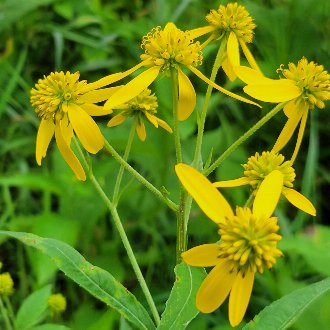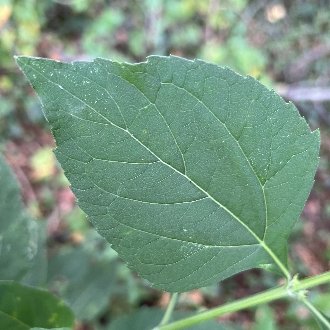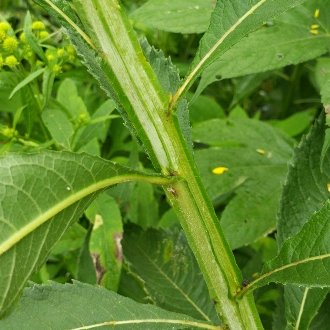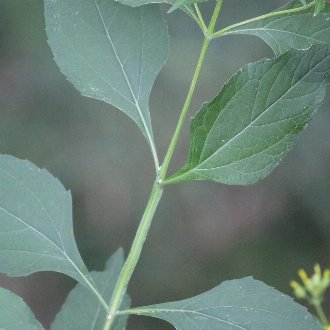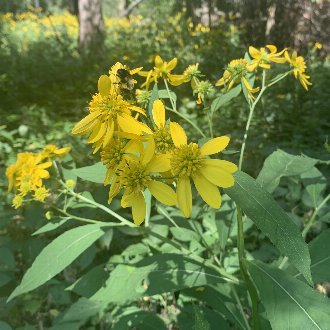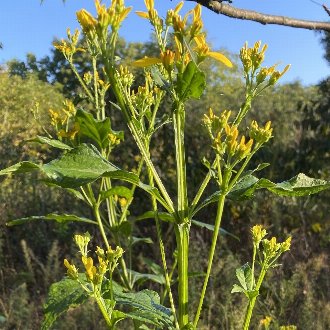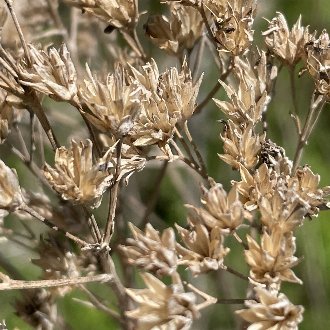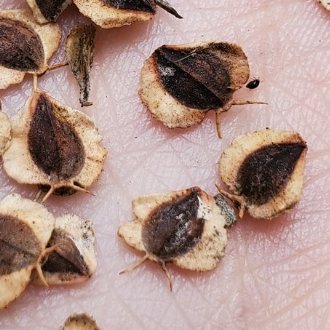Wingstem vs Yellow Crownbeard
These species are visually similar and are easily confused, especially as young V. alternifolia plants can have opposite leaves. They are easily distinguished, however, by a long list of subtle differences including in flowerheads, seedheads, and leaf shape. V. alternifolia ranges farther north and much farther west, whereas V. occidentalis ranges farther into the southeastern coastal plain. Their habitats have significant overlap, but V. occidentalis is slightly more tolerant of dry conditions and favors more disturbed sites and sites with rockier soils, whereas V. alternifolia is more common at higher elevations.
Wingstem (Verbesina alternifolia) | Yellow Crownbeard (Verbesina occidentalis) |
A tall perennial native to North America, with showy, yellow flowers. | A tall perennial native to the southeastern US. |
Flowerheads form with 6-8 rays, rarely more or less. Rays are lost over time. Rays are slightly larger. Photo © Alexandra Destria, CC BY 4.0. | Flowerheads form with 1-3 rays, rarely more or none. Rays are lost over time. Rays are slightly smaller. Photo © Hayes Valentine, CC BY 4.0. |
Far more disc florets, usually 40-60, occasionally more. Disc florets arranged in a globe shape, pointing in many different directions. Photo © Jeff Wilson, CC BY 4.0. | Far fewer disc florets: usually 8-15, occasionally more. Disc florets mostly pointing in roughly the same direction. Photo © David George, CC BY 4.0. |
Leaves average longer (10-25+cm) and narrower relative to their width. Leaves always taper to a long point at the tip. Photo © Liz Crafford, CC BY 4.0. | Leaves average shorter (6-12cm) and more stout. Leaves often, but do not always taper to a long point. Leaves relatively more likely to have a simple acute angle, or rarely, to be slightly rounded at the tip. Photo © jdshide, Public Domain. |
Leaves are opposite on seedlings and sometimes young shoots, but is usually alternate on mature plants higher up on the stem. Photo © Ken-ichi Ueda, CC BY 4.0. | Leaves and branching is opposite throughout almost the entire plant, always opposite near the main stem. Photo © Ashwin Srinivasan, CC BY 4.0. |
Fewer, larger flowerheads, typically 8-25 on mature plants, sometimes more. Photo © Holly Sanderson, CC BY 4.0. | More numerous, smaller flowerheads, typically 20-100 on mature plants, sometimes more. Photo © Bonnie Semmling, CC BY 4.0. |
Seedheads are globe-shaped. Awns stick out in all directions except towards the base. Photo © bobistraveling, CC BY 4.0. | Seedheads are upright, cup-shaped at base. Awns mostly pointing in similar directions, in the direction of the seedhead. Photo © Becky, Public Domain. |
Empty seedheads still show more globe-shaped symmetry. Photo © Emily Summerbell, CC BY 4.0. | Empty seedheads still show more upwards orientation. Photo © Becky, Public Domain. |
Seeds are winged. Awns much shorter (1.5-2mm) Photo © Katie Kucera, CC BY 4.0. | Seeds are ridged, but not winged. Awns much longer (3-4mm) Photo © Brandon Wheeler, Public Domain. |
References & External Resources
These short lists show only links helpful for ID. For a complete list of references and resources also covering other aspects of ecology, visit the links section of the full article on each plant, which is the first entry here.



